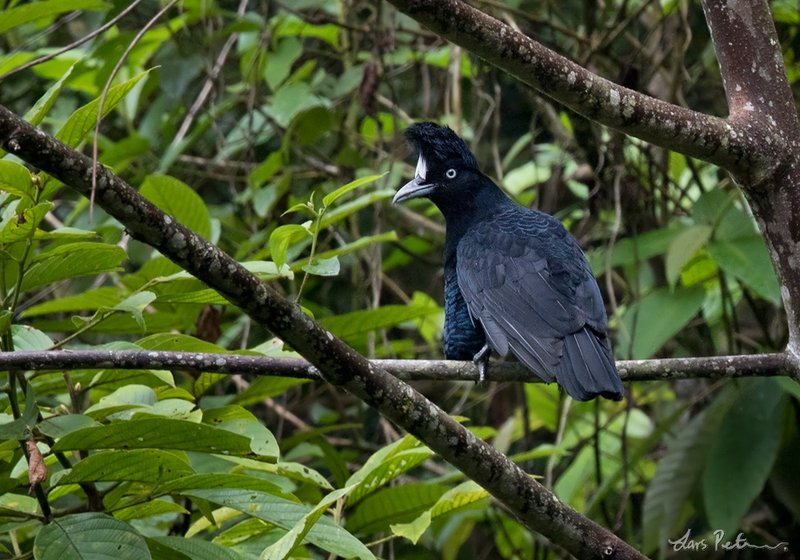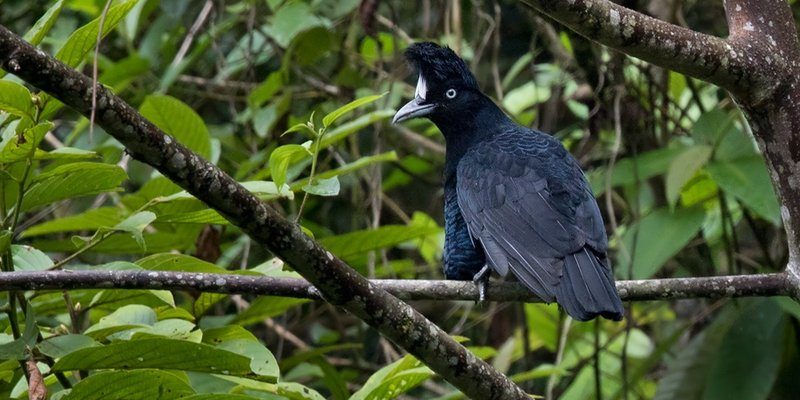
Imagine a bird that looks like it’s ready for a fancy brunch, complete with a stylish umbrella on its head. That’s the Umbrellabird for you! This unique creature, native to the tropical rainforests of Central and South America, is not just a pretty sight; it has some fascinating behaviors and characteristics that make it stand out in the avian world. With its dramatic appearance and interesting habits, the Umbrellabird captures the hearts of bird watchers and nature enthusiasts alike.
The Umbrellabird is known for its large crests, which resemble an umbrella when fully displayed. This striking feature is more than just a fashion statement; it plays a crucial role in courtship rituals. Males use their crests to attract mates, puffing them up and swaying them side to side to show off their size and color. It’s like a feathered dance contest, and only the most impressive dancers win the attention of potential partners.
In this article, we’ll dive deeper into the world of the Umbrellabird, exploring its habitat, diet, behavior, and much more. If you’ve ever been curious about this remarkable bird, you’re in for a treat!
Physical Characteristics of the Umbrellabird
The Umbrellabird is a standout with its striking features. Adults can reach lengths of about 18–24 inches, making them relatively large for tropical birds. Their most notable feature, the umbrella-like crest, can be quite impressive. Some males can even have crests that are as long as their bodies! This crest is not just for show; it can also be raised or lowered, allowing the bird to express itself.
In terms of coloration, the Umbrellabird has mostly black plumage. However, some species show hints of vibrant colors, especially during mating season. Their feathers are not just for aesthetics; they provide excellent camouflage within the shadowy rainforests. This helps them avoid predators while they navigate their lush, leafy surroundings.
Their beaks are also noteworthy. Umbrellabirds have long, slightly curved beaks that allow them to feed on fruits and insects. This shape is perfect for reaching into tight spots to forage for food. Some species even have distinctive throat pouches that can inflate during calls, adding to their unique physical presence.
Habitat and Distribution
Umbrellabirds can be found in the humid tropical rainforests of Central and South America. They thrive in environments where they can easily access food and nests for breeding. Their primary range includes parts of Colombia, Ecuador, and the surrounding regions. Tropical rainforests, with their dense foliage and abundant food sources, provide the perfect setting for these birds to flourish.
These birds prefer the canopy layer, often seen perched on branches high above the ground. They’re experts at blending into their surroundings, which helps them avoid detection from both predators and humans. The lush greenery offers plenty of cover, allowing them to remain relatively elusive.
However, it’s important to note that habitat loss due to deforestation poses a significant threat to Umbrellabird populations. As these beautiful rainforests are cut down for agriculture and urban development, their home and food sources are diminishing. Conservation efforts are crucial to protect these unique birds and ensure they continue to thrive in the wild.
Diet and Feeding Habits
When it comes to food, the Umbrellabird is an omnivore. Their diet primarily consists of fruits, berries, and insects. They are especially fond of fig trees, which are abundant in their rainforest habitats. Feeding on fruits helps them obtain the necessary nutrients while also aiding in seed dispersal, an important ecological role.
Their long, curved beaks allow them to reach deep into flowers and fruit, making it easier to access nectar and ripe fruit. It’s fascinating to watch them feed, as they gracefully navigate the branches while searching for food, often hanging upside down when the need arises. This unique feeding strategy is part of what makes them so intriguing to observe.
Insects are also a key part of their diet, providing essential proteins. During the breeding season, when their energy needs increase, they may increase their insect intake to support their reproductive activities. The combination of fruits and insects gives these birds a well-rounded diet that supports their active lifestyle.
Behavior and Social Structure
Umbrellabirds are generally solitary or found in small groups, especially outside the mating season. During the breeding season, however, males become more social as they engage in courtship displays to attract females. These displays often involve puffing up their crests and making loud, unique calls that can be heard for miles. It’s a bit like their own version of a musical performance, where only the best singers win the attention of potential mates.
They are known for their vocalizations, which include low, booming calls that resonate through the forest. These sounds are not only used for mating but also for communication among individuals. Each species of Umbrellabird has its own distinct calls, making it easier for them to recognize one another.
While they may seem shy, Umbrellabirds are quite curious. They will often approach humans, especially if food is involved. However, they are incredibly cautious creatures; if they sense danger, they quickly take off into the trees, disappearing from sight in an instant. This balance of curiosity and caution is a fascinating aspect of their behavior.
Reproduction and Lifespan
The breeding season for the Umbrellabird usually occurs between March and June. Males are particularly vocal during this time as they try to impress females. Once a male attracts a mate, the two will establish a territory for nesting purposes. The female will then build a nest, typically in the fork of a tree branch.
The nest is often made from twigs, leaves, and other organic materials. Once completed, the female lays 1 to 3 eggs, which she alone incubates for about 21 to 30 days. After hatching, the chicks are dependent on their mother for food and protection, making the early weeks critical for survival. The young birds will leave the nest after 3 to 4 weeks but continue to rely on their parents for a while longer.
In terms of lifespan, Umbrellabirds can live up to 10 years in the wild. However, in captivity, where they face fewer threats, some have been known to live even longer. Their longevity, combined with their unique behaviors and striking appearances, makes them a fascinating subject for ornithologists and bird enthusiasts alike.
Conservation Status
As enchanting as they are, Umbrellabirds face several threats that put their populations at risk. Deforestation and habitat loss are the most significant concerns, primarily due to agriculture and urban expansion. As their habitats shrink, these birds find it increasingly challenging to find food and nesting sites.
Some species of Umbrellabird, like the Great Umbrellabird, are classified as near threatened. Conservation efforts are crucial to protect their habitats and ensure these beautiful birds can thrive in the wild. Organizations dedicated to preserving rainforests are vital in this mission, as they work tirelessly to fight against deforestation and promote awareness of these unique creatures.
Additionally, eco-tourism can play a role in conservation. By promoting bird-watching and other sustainable practices, we can help create economic incentives for protecting rainforests. When local communities see the benefits of conserving their natural habitats, they might prioritize preservation efforts over development.
Interesting Facts About the Umbrellabird
| Common Name: | Umbrellabird |
| Scientific Name: | Cephalopterus spp. |
| Size: | 18–24 inches |
| Habitat: | Tropical rainforests |
| Diet: | Fruits and insects |
| Lifespan: | Up to 10 years |
FAQ
What does the Umbrellabird’s call sound like?
The Umbrellabird has a distinctive deep, booming call that can carry quite a distance through the dense rainforest. Males use this vocalization during courtship and territorial displays. Their calls can sound almost like a drumbeat, resonating throughout their habitat, which is fascinating to hear in person.
Are all Umbrellabirds the same species?
No, there are several species of Umbrellabird, each with unique characteristics and ranges. The most notable ones include the Great Umbrellabird, the Long-wattled Umbrellabird, and the Amazonian Umbrellabird. Each species has its distinct features and habitats, but they all share that iconic crest and captivating behavior.
How do Umbrellabirds build their nests?
Female Umbrellabirds are responsible for building nests. They typically construct them in the forks of trees and use twigs, leaves, and other natural materials to create a safe space for their eggs. The location is crucial, as it helps protect the nest from potential predators while providing access to food sources nearby.
Do Umbrellabirds migrate?
Umbrellabirds are generally not migratory but may move locally in response to changes in food availability or environmental conditions. They tend to stay within their established territories, so you’ll often find them in the same area throughout their lives unless their habitat is significantly altered.
What role do Umbrellabirds play in their ecosystem?
Umbrellabirds play a vital role in their ecosystem, particularly in seed dispersal. As they feed on fruits, they help transport seeds throughout the rainforest. This natural process supports the growth of new plants and maintains the biodiversity of their habitats, making them important contributors to the health of their ecosystem.
Can Umbrellabirds be kept as pets?
Keeping an Umbrellabird as a pet is not advisable. These birds have specialized needs and require a specific environment to thrive, which is difficult to replicate in captivity. Moreover, they are wild animals that are best appreciated in their natural habitats. Instead of keeping them as pets, consider supporting conservation efforts to protect their populations in the wild.
How can I help protect Umbrellabirds?
There are several ways to help protect Umbrellabirds and their habitats. Supporting organizations that work on rainforest conservation is one way. You can also choose sustainable products that do not contribute to deforestation. Lastly, promoting eco-tourism can create economic incentives for protecting these beautiful birds and their environments.
What is the best time to see Umbrellabirds in the wild?
The best time to see Umbrellabirds is during their breeding season, which typically occurs from March to June. Males are particularly active during this time, showcasing their courtship displays and vocalizations. Visiting rainforests during this period increases your chances of witnessing their fascinating behaviors firsthand.
What are the main threats facing Umbrellabirds?
The main threats facing Umbrellabirds include habitat loss due to deforestation, agricultural expansion, and urban development. As rainforests are cut down, these birds lose their homes and food sources. Additionally, they face challenges from hunting and the capture for the pet trade in some regions, further endangering their populations.
Are Umbrellabirds social creatures?
While Umbrellabirds are generally solitary or found in small groups, especially outside of the breeding season, they do exhibit social behaviors during mating. Males become more social as they compete for female attention, often gathering in areas where they can display and call. This temporary socialization adds an interesting dynamic to their otherwise solitary lifestyle.
Is it safe to observe Umbrellabirds in the wild?
Observing Umbrellabirds in their natural habitat can be a safe and rewarding experience if done respectfully. Many eco-tourism companies offer guided bird-watching tours in areas where these birds are found. It’s important to follow guidelines for responsible wildlife viewing, such as keeping a safe distance and minimizing noise, to ensure the safety of both the birds and the observers.
What do Umbrellabirds symbolize?
Umbrellabirds often symbolize beauty and uniqueness due to their striking appearance and fascinating behaviors. In many cultures, they are seen as a representation of the vibrant life found within the rainforests they inhabit. Their involvement in the ecosystem also emphasizes the importance of biodiversity and conservation efforts, reminding us of the delicate balance of nature.

